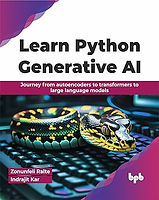Python : Basic For Beginners
What is Python?
Python is a high-level, interpreted, general-purpose programming language. Let's break that down:
-
High-Level: It's designed to be easy for humans to read and write, closer to natural language than machine code. This means you don't have to worry about low-level details like memory management.
-
Interpreted: Python code is executed line by line by an interpreter, rather than being compiled into machine code first. This makes development faster and more flexible.
-
General-Purpose: Python is versatile and can be used for a wide variety of tasks, including:
-
Web development (backend)
-
Data analysis and machine learning
-
Scripting and automation
-
Scientific computing
-
Game development
-
Desktop GUI applications
-
Key Features of Python:
-
Interpreted Language: Python code is executed line by line, which simplifies debugging and testing.
-
Dynamic Typing: You don’t need to declare variable types explicitly, allowing for more flexibility in coding.
-
Multi-Paradigm Support: Python supports various programming styles, including procedural, object-oriented, and functional programming.
-
Rich Standard Library: Often described as a "batteries included" language, Python comes with a comprehensive standard library that supports many tasks, from web development to data analysis.
Common Uses:
-
Web Development: Frameworks like Django and Flask make it easy to build web applications.
-
Data Science and Machine Learning: Libraries such as Pandas, NumPy, and TensorFlow are widely used for data analysis and machine learning tasks.
-
Automation: Python is often used for scripting and automating repetitive tasks.
Installing Python is straightforward! Here’s a step-by-step guide for different operating systems:
For Windows:
-
Download the Installer:
-
Go to the official Python website and download the latest version.
-
-
Run the Installer:
-
Double-click the downloaded file to start the installation.
-
Make sure to check the box that says "Add Python to PATH" before clicking "Install Now."
-
For macOS:
-
Download the Installer:
-
Visit the Python downloads page and download the macOS installer.
-
-
Run the Installer:
-
Open the downloaded file and follow the installation instructions.
-
-
Verify Installation:
-
Open Terminal and type python3 --version to confirm the installation.
-
Categories of Operators in Python (Based on Functionality):
-
Arithmetic Operators:
-
These perform mathematical calculations.
-
Examples: +, -, *, /, //, %, **
-
They primarily work with numeric types (integers, floats, complex numbers).
-
While the input is numeric, the result is also usually numeric.
-
-
Assignment Operators:
-
These assign values to variables.
-
Examples: =, +=, -=, *=, /=, //=, %=, **=
-
They usually change the state of a variable (modifying its value).
-
The "type" involved can be almost any type depending on what is being assigned.
-
-
Comparison Operators:
-
These compare values and return a boolean result (True or False).
-
Examples: ==, !=, >, <, >=, <=
-
They can compare various data types (numbers, strings, etc.).
-
The output will be a boolean type.
-
-
Logical Operators:
-
These combine or modify boolean expressions.
-
Examples: and, or, not
-
They operate on boolean operands and produce boolean results.
-
-
Identity Operators:
-
These check if two operands are the same object in memory.
-
Examples: is, is not
-
They operate on any type of object and produce boolean results (checking identity not necessarily value).
-
-
Membership Operators:
-
These check for the presence of a value within a sequence.
-
Examples: in, not in
-
They operate on sequences (lists, strings, tuples, sets, etc.) and produce a boolean result (checking if the target is present).
-
-
Bitwise Operators:
-
These operators perform operations at the bit level on integers.
-
Examples: &, |, ^, ~, <<, >>
-
They manipulate integers at the individual bit level. The inputs and outputs are integers.
-








.jpg)



